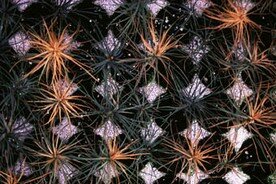
Variation in autumn cold acclimation among Scots pine seedlings is indicated by injury after artificial freeze testing.
Forest tree populations have reached certain degrees of adaptation, over many generations, to local climate and photoperiod conditions. In northern latitudes the adaptation is strongly related to survival and reproduction under conditions with long, cold winters and short summers. In these areas, early cold acclimation rhythms are usually the most critical factor for survival. The cold acclimation is initiated by elongation of the nights in late summer, and northern populations are adapted to initiate cold acclimation at shorter night lengths than more southern populations. For Pinus sylvestris strong clinal covariation of survival and phenological traits with the latitude of origin has been verified in numerous provenance studies under field, climate chamber and greenhouse conditions. However, the adaptation to the present climate is usually far from perfect because of factors such as the variability of climate/weather conditions over time and the continuous geographic distribution of the species, which allows gene exchange between populations by long distance pollen transfer. As a consequence of this non-optimal adaptation, provenance selection (usually involving southern transfer of seeds) and breeding for adaptation increases survival and volume production compared to regeneration with local seeds.
Genetic variation and natural pollen clouds of Pinus sylvestris
In our projects we are studying:
- the genetic variation in traits related to cold acclimation of P. sylvestris,
- the importance (and duration) of physiologi cal after-effects of maternal growth environment in:
a) progeny testing and
b) selection for northern latitudes,
- the influence of long distance pollen tranfer on
a) the adaptation of natural forests
b) tree hardiness, and
c) geographical utilization of seeds from Swedish seed orchards.
Basic methods being applied in the studies are:
- artificial freeze testing under controlled conditions simulating natural conditions
- phenological observations in short term experiments in climate chamber, greenhouse, nursery and field experiments.

Isolation of female flowers allows fertilization with pollen from selected parents.
Isolation of female flowers allows fertilization with pollen from selected parents.
Freeze testing of whole plants and repeated freeze testing of detached needles (non-destructive for the tested plants) is used to study genetic variation and changes in cold hardiness over the year. The use of artificial freeze testing during late summer and autumn to assess climate adaptation is justified by the high correlations found between injuries during freeze testing of one- and two- year old plants and mortality due to weather and climatic factors in 10-20 year old field trials of provenances and families. Forest trees produce enormous amounts of pollen that can carry genes over long distances if winds and other weather conditions are favourable. In Sweden southerly winds often prevail during the flowering period, carrying ”unhardy” southern genes to fertilize northern populations. However, wind directions vary both within and among years, probably causing pollen of different geographical origins and genetic characteristics to fertilize trees at various localities, and for similar variations to occur at the same locality on different days and in different years. In this project we are studying whether differences in hardiness and geographical origin of the background pollen can be estimated by comparing progenies from open pollination and progenies from controlled crossing of the same mother trees with pollen from different latitudes. The close relationship between autumn frost hardiness and latitude of origin will then be exploited to estimate the latitudinal origin of natural pollen clouds. For this purpose, seventeen clone archives, including grafts of ten Scots pine clones (selected for poor pollen production) were planted in central and northern Sweden. They will act as mother trees for the background pollen and were therefore planted in areas with few natural Scots pine trees. We also are studying whether mobile grafts can be used as pollen receivers at any locality without loss of precision of the pollen population estimates obtained from progeny testings caused by physiological after-effects of the graft treatment.
Selected publications:
Nilsson, J.-E. & Andersson, B. () Performance in freezing tests and field experiments of full-sib families of Pinus sylvestris (L.). Can. J. For. Res. 17: .
Nilsson, J.-E. & Walfridsson, E.A. () Autumn freeze testing of one-year reciprocal families of Pinus sylvestris (L.). Scand. J. For. Res 5: 501-511.
Nilsson, J.-E., Andersson, B. & Walfridsson, E.A. () Progeny freeze testing, progeny field testing and parental phenology of Pinus sylvestris (L.) clones in northern Sweden. Scand. J. For. Res. 6: 177-195.
Nilsson, J.-E. () Growth and survival of spontaneous provenance hybrids of Pinus sylvestris. Scand. J. For. Res. 7: 193-203.
Nilsson, J.-E. () Genetic variation in the natural pollen cloud of Scots pine - a study based on progeny testing. Scand. J. For. Res. 10: 140-148.
Nilsson, J.-E. () Phenological variation among plus-tree clones of Pinus sylvestris (L.) in northern Sweden. Silva Genetica 44: 20-28.
Nilsson, J.-E. () Seasonal changes in phenological traits and cold hardiness of F1-populations from plus-trees of Pinus sylvestris and Pinus contorta of various geographical origins. Scand. J. For. Res. 16: 7-20.
|